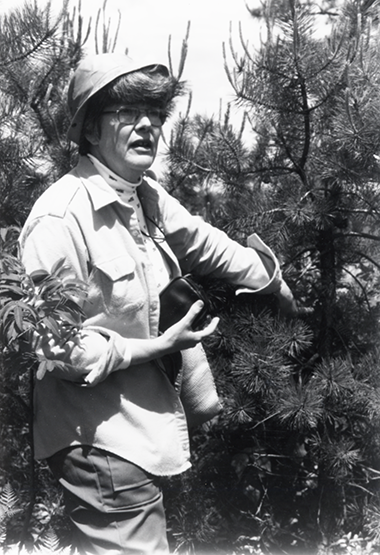Throwback Thursday: Heroine of Conservation
 |
|
Margaret "Meg" Stewart, leading a field trip in the Albany Pine Bush. (Photo courtesy of UAlbany Archives) |
ALBANY, N.Y. (September 21, 2017) — Margaret Stewart was not a reluctant leader among conservationists. She was just a bit amazed by it at times.
Around 1977, 21 years into her faculty tenure with the University's Biology department, when promoting a new course related to the preservation of natural resources called “World Food Crisis,” she commented, “This isn’t even my field — I am a vertebrate biologist who works on frogs.”
A frog bears her name as proof. Included in her landmark text Amphibians of Malawi (1967) is an African frog she was the first to collect. It came to be known scientifically as the Phrynobatrachus stewartae — more commonly and affectionately “Stewart's Puddle Frog.” A rarity as a Ph.D. holding woman of science in the ‘50s, she became in 1979 the first female elected president of the American Society of Ichthyologists and Herpetologists (the latter are frog-studiers).
So, not her field, but at least an occupier of a chamber of her heart. “Meg” Stewart didn’t originate UAlbany’s academic and scholarly concern for conservation biology — the management of nature and of Earth's biodiversity with the aim of protecting species, their habitats, and ecosystems; when she joined the faculty in 1956 her colleague Allen Benton was already teaching a course in conservation biology.
But Meg became the guiding force rallying the University’s talent toward strength and commitment to environmental science. A beloved teacher, she not only fought to lift and transport UAlbany scholarship to the world's benefit, but was a force in the region’s ecology movement. And she did so with power of persuasion and wit, accompanied by more than a trace of her native North Carolina twang, that overleaped hurdles.
“In response to those who objected to corporate funding to protect places like the Albany Pine Bush, she would reply that she was not concerned about ‘tainted’ money, because there ‘t’ain’t enough of it,’” recalled her longtime colleague, Professor George Robinson, interim director of the master’s level Biodiversity, Conservation and Policy Program.
Stewart championed that program in 1997 and came out of retirement to be its first director for three years. Biologist Gary Kleppel, who directed Biodiversity, Conservation and Policy from 2000 until his retirement this fall, said “as a creative and independent thinker, she was a force of nature. Her understanding that modern problems in conservation can only be solved by working across disciplines led to the creation of the program.”
Stewart was one of the new breed of faculty that joined the biology department the mid 1950s: equipped with scholarly research and remarkable abilities to teach. But in Meg there was also a talent to take charge, even when SUNY was going through financial stress. “Two times I picked up the ball and tried to save programs relating to natural resources,” Stewart recalled in 2000.
In 2003, her generous endowment gift established of the Margaret M. Stewart Graduate Scholarship in Biodiversity, Conservation, and Policy. She also left a major donation to The Nature Conservancy. An interpretive trail in the Albany Pine Bush and the visitors center at Sam’s Point Preserve are named in her honor.
Meg passed away in 2006 after battling pancreatic cancer. Despite her advancing illness, she continued to attend student seminars and thesis defenses until near the very end.
"She spent a lifetime doing the difficult things that others shirked, and her fierce Scots integrity stands out in all her accomplishments," said Robinson.
![]() For more news, subscribe to UAlbany's RSS headline feeds
For more news, subscribe to UAlbany's RSS headline feeds
A comprehensive public research university, the University at Albany-SUNY offers more than 120 undergraduate majors and minors and 125 master's, doctoral and graduate certificate programs. UAlbany is a leader among all New York State colleges and universities in such diverse fields as atmospheric and environmental sciences, business, education, public health,health sciences, criminal justice, emergency preparedness, engineering and applied sciences, informatics, public administration, social welfare and sociology, taught by an extensive roster of faculty experts. It also offers expanded academic and research opportunities for students through an affiliation with Albany Law School. With a curriculum enhanced by 600 study-abroad opportunities, UAlbany launches great careers.


